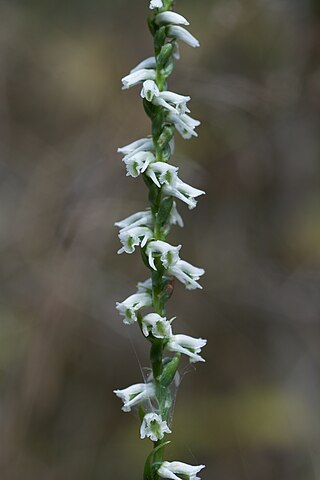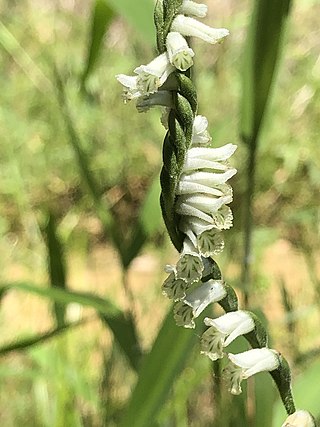
Spiranthes is a genus of orchids in the subfamily Orchidoideae. They are known commonly as ladies tresses, ladies'-tresses, or lady's tresses. The genus is distributed in the Americas, Eurasia, and Australia. The genus name Spiranthes is derived from the Greek speira ("coil") and anthos ("flower"), and was inspired by the spirally arranged inflorescence.

Spiranthes romanzoffiana, commonly known as hooded lady's tresses or Irish lady's-tresses, is a species of orchid. Collected by Chamisso during the Romanzov expedition it was described by him in 1828 and named for Count Nikolay Rumyantsev who financed the expedition. This orchid is native to North America, Ireland and the British Isles.

Spiranthes cernua, commonly called nodding lady's tresses, or nodding ladies' tresses, is a species of orchid occurring from Maritime Canada to the eastern and southern United States. As the common name suggests cernua means "nodding", or "bowed" in Latin.

Spiranthes ochroleuca, commonly called the yellow nodding lady's tresses, is a species of orchid occurring from southeastern Canada to the eastern United States.

Spiranthes porrifolia is a species of orchid known by the common names creamy lady's tresses and western ladies' tresses. It is native to the western United States from Washington and Idaho to southern California. It can be found in moist habitats, such as mountain meadows, swamps, fens, and riverbanks. It is a perennial herb growing from a tuberous root system, reaching a maximum height around 60 cm (24 in). The leaves are mainly located around the base of the erect stem. They are linear or lance-shaped, or sometimes nearly oval. The top of the stem is occupied by the inflorescence, a dense spiral of many flowers. Each flower is somewhat tubular, with an upper and lower lip, and cream to yellowish in color.

Spiranthes delitescens is a rare species of orchid known by the common names reclusive lady's tresses, Canelo Hills lady's tresses, and Madrean lady's tresses. It is native to Arizona in the United States, where there are only four occurrences. It is threatened by the loss and degradation of its habitat. It is a federally listed endangered species of the United States.

Spiranthes diluvialis is a rare species of orchid known as Ute lady's tresses. The species name diluvialis means "of the flood". It is native to the western United States, where there are scattered, mostly small occurrences in the states of Colorado, Idaho, Montana, Nebraska, Nevada, Utah, Washington, and Wyoming. An occurrence was recently discovered in southern British Columbia. The plant faces a number of threats to its existence. It is a federally listed threatened species of the United States.

Cirsium eatonii, commonly known as Eaton's thistle or mountaintop thistle, is a North American species of flowering plants in the family Asteraceae.

Spiranthes lacera, commonly called the slender ladies'-tresses, is a species of orchid that is native to Eastern North America. It has a widespread range and is found in a variety of open habitats, both natural and disturbed. It produces a spiral of white flowers in the summer.

Spiranthes odorata, marsh lady's tresses or common lady's tresses, is a species of flowering plant in the orchid family, native to the southeastern United States, from Texas eastwards and northwards to Delaware. It grows in moist, partially shaded environments with acidic or neutral soil.
Bidens eatonii is a North American species of flowering plant in the family Asteraceae. It is native to eastern Canada and the northeastern United States.

Spiranthes lucida, the shining ladies'-tresses, is a species of orchid native to northeastern North America.

Platanthera shriveri, Shriver's purple fringed orchid, is a rare orchid endemic to the United States. It is considered critically imperiled.

Spiranthes torta, the Southern ladies’ tresses, is a terrestrial orchid native to Florida, Mexico, Central America, the Caribbean Islands and Bermuda.

Spiranthes brevilabris, the short lipped ladies' tresses or Texas lady's tresses is a rare and endangered orchid native to the southeastern United States.

Spiranthes longilabris, the long lipped ladies' tresses is an orchid endemic to the southeastern United States.

Spiranthes praecox, the grass leaved ladies' tresses, green-vein ladies'-tresses or sometimes giant ladies' tresses is a terrestrial orchid endemic to the United States, growing on the eastern coastal plains and around the Gulf Coast.

Spiranthes sylvatica, the woodland ladies' tresses or pale-green ladies'-tresses is a terrestrial orchid endemic to the United States, very similar in appearance and range to Spiranthes praecox which it had been considered a variation of for a long time.

Spiranthes laciniata, the lacelip ladies' tresses is a terrestrial orchid endemic to the south eastern United States.

Spiranthes casei, or Case's lady's tresses, is a species of orchid native to the northeastern United States and Canada.



















